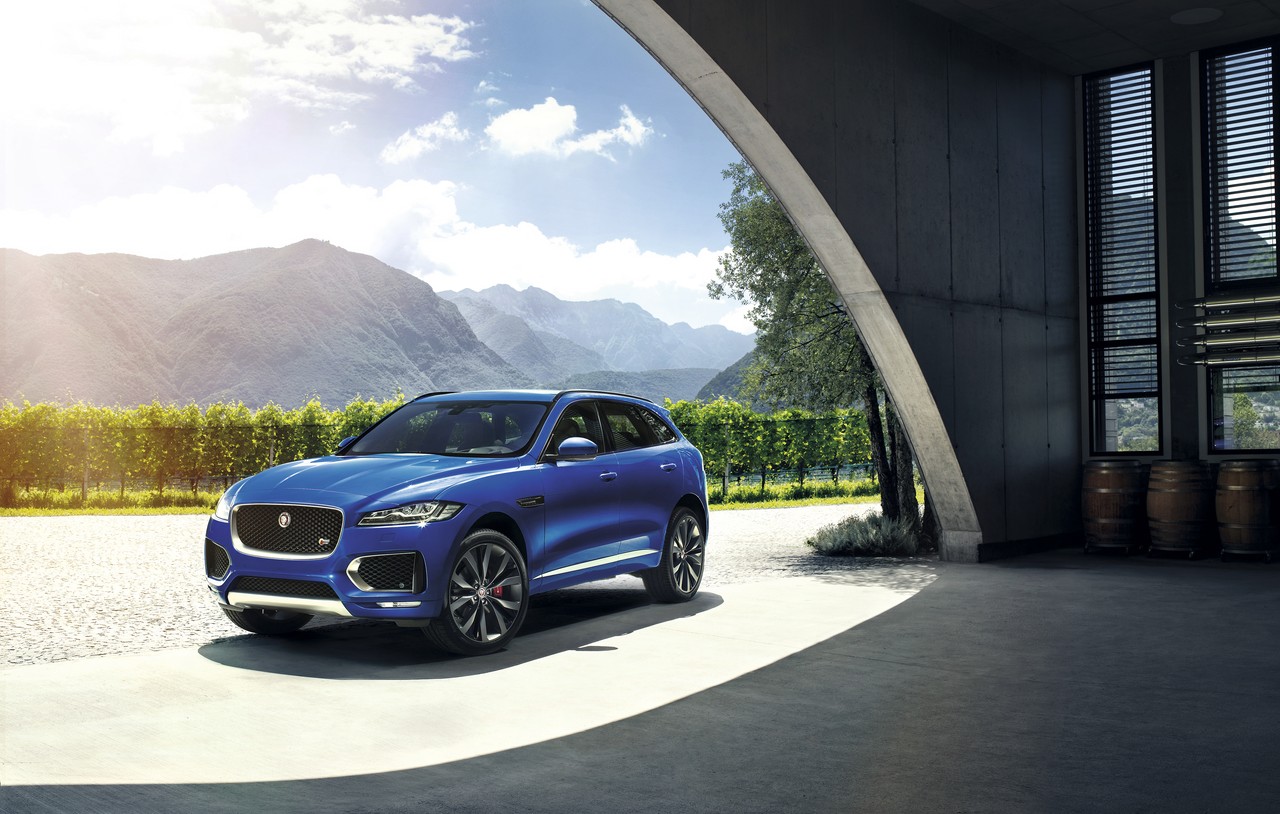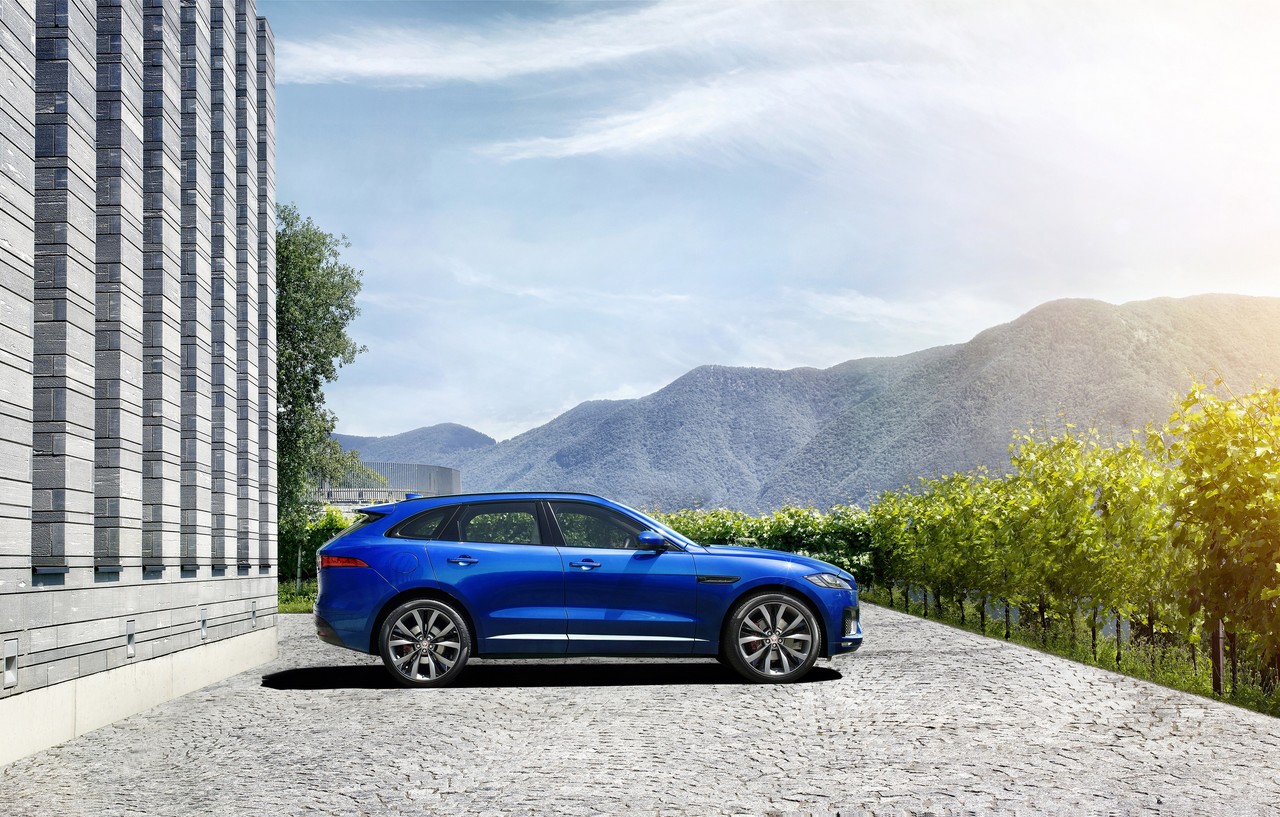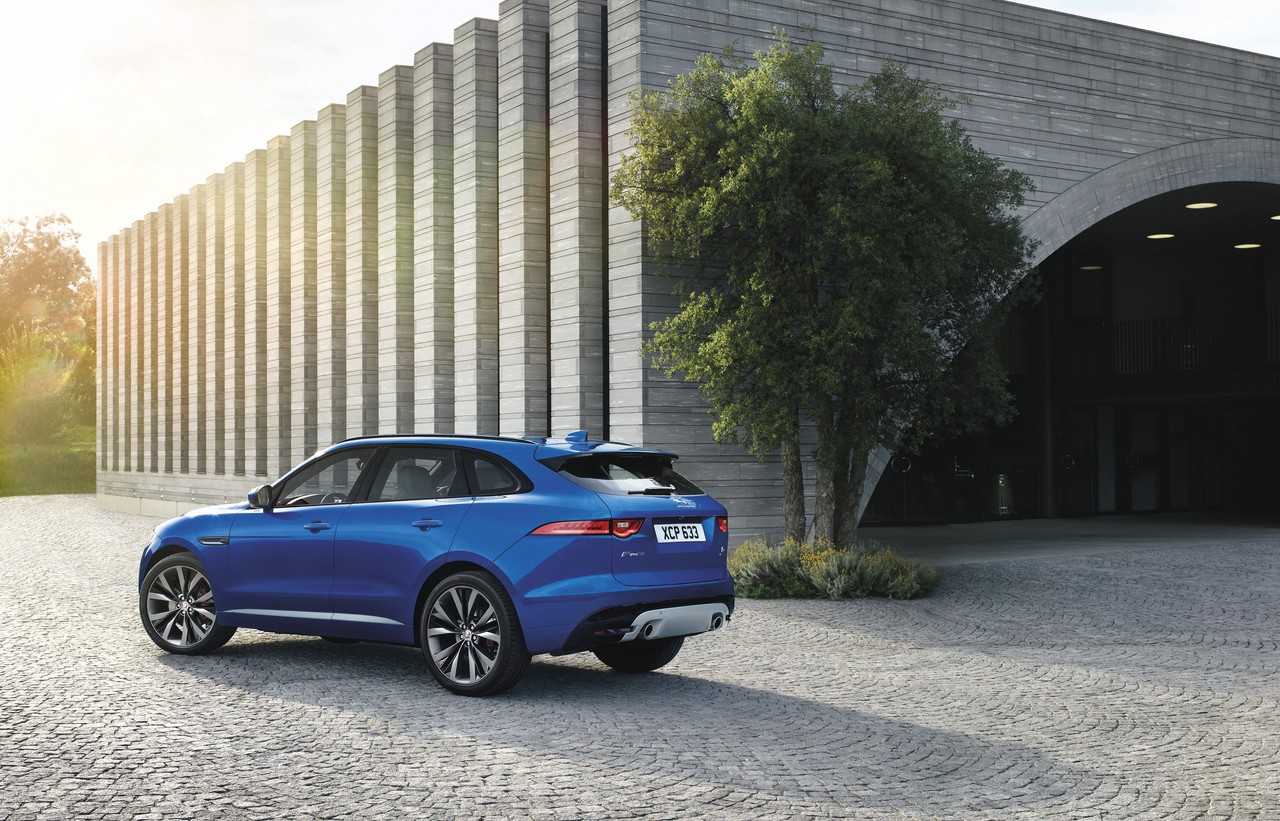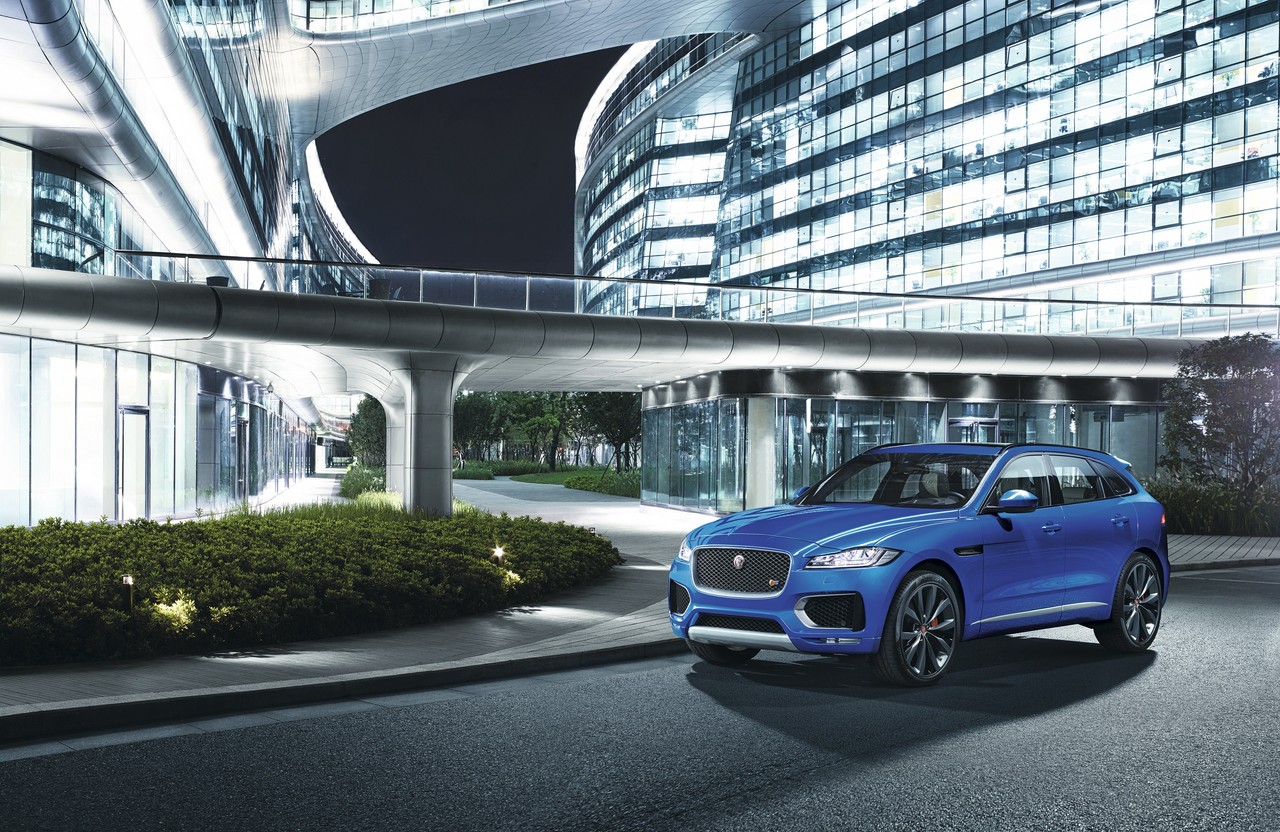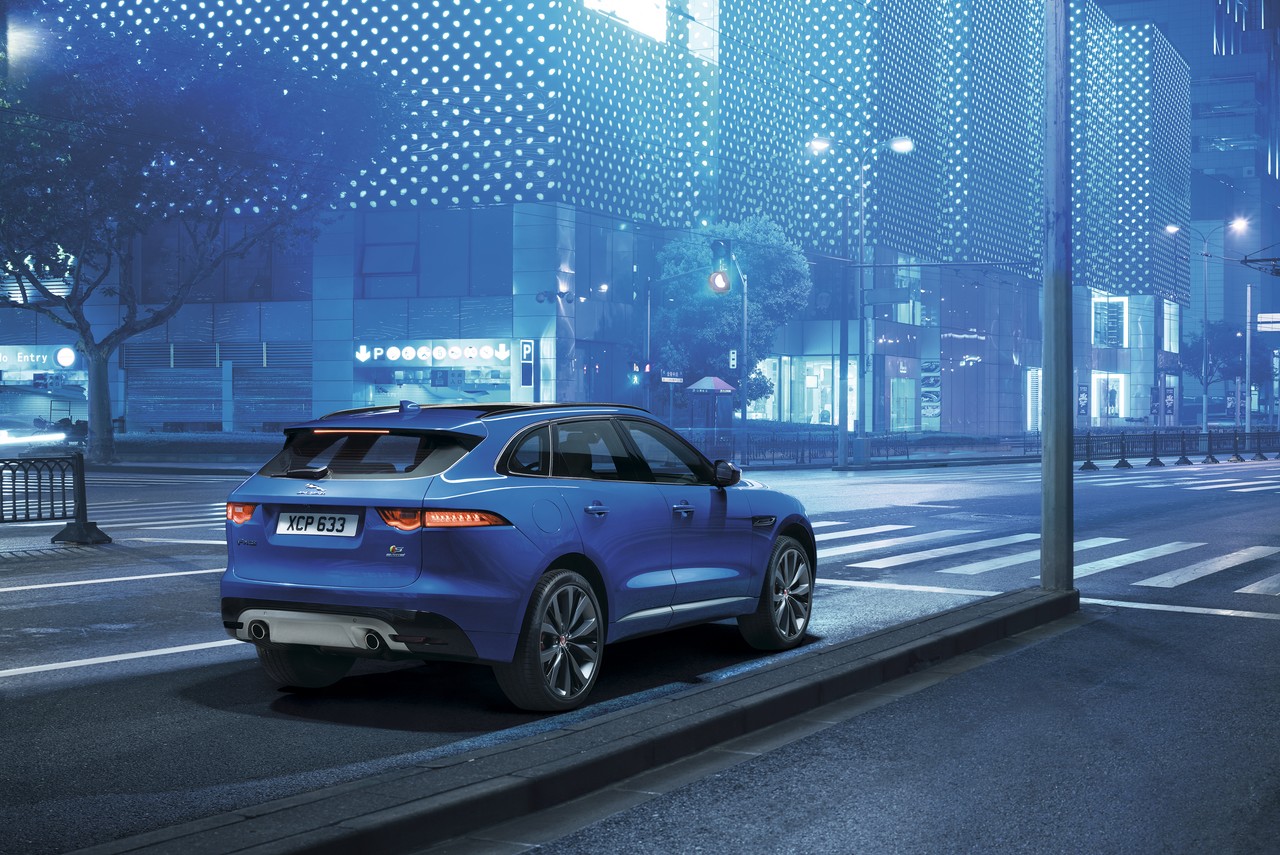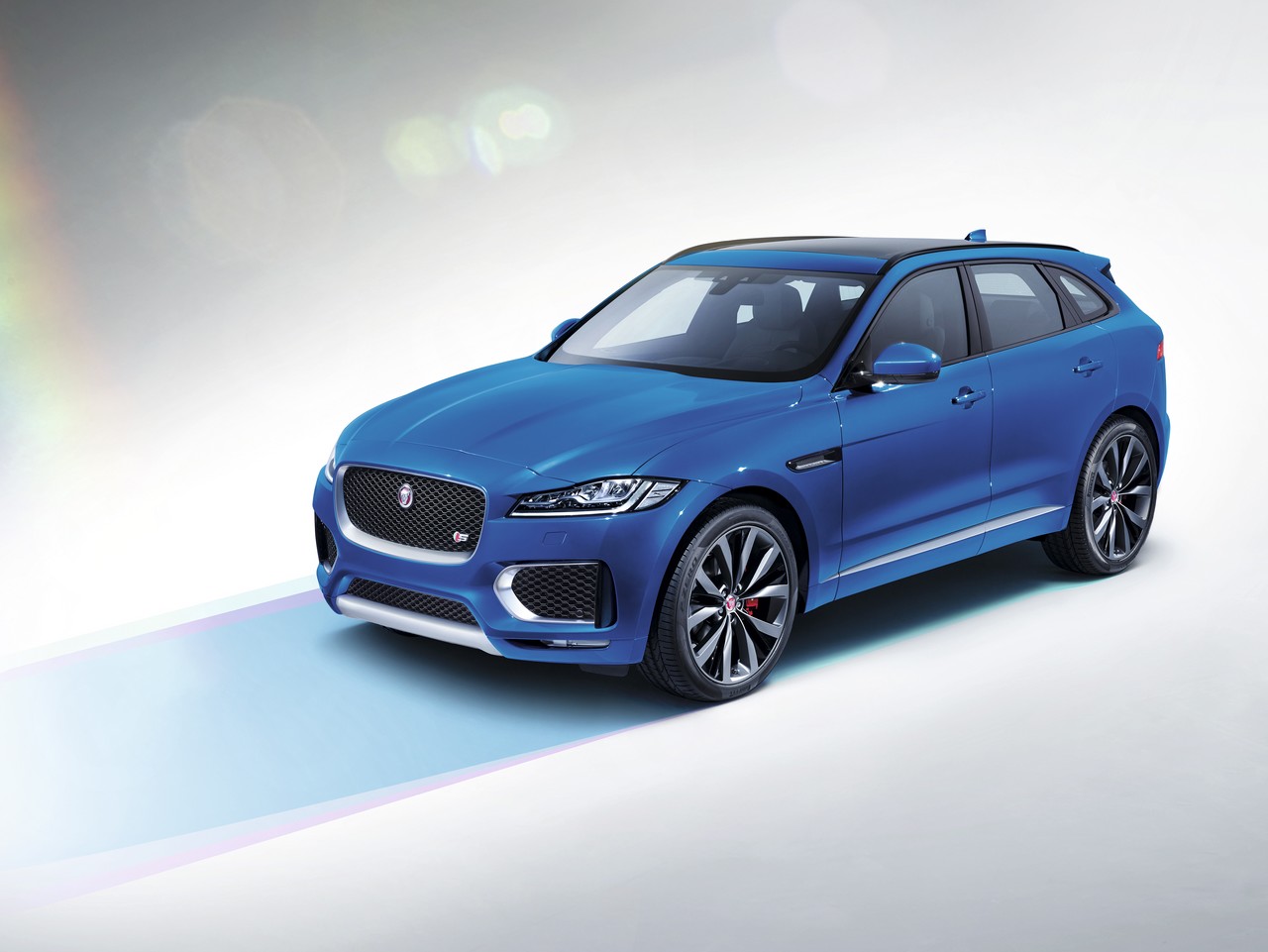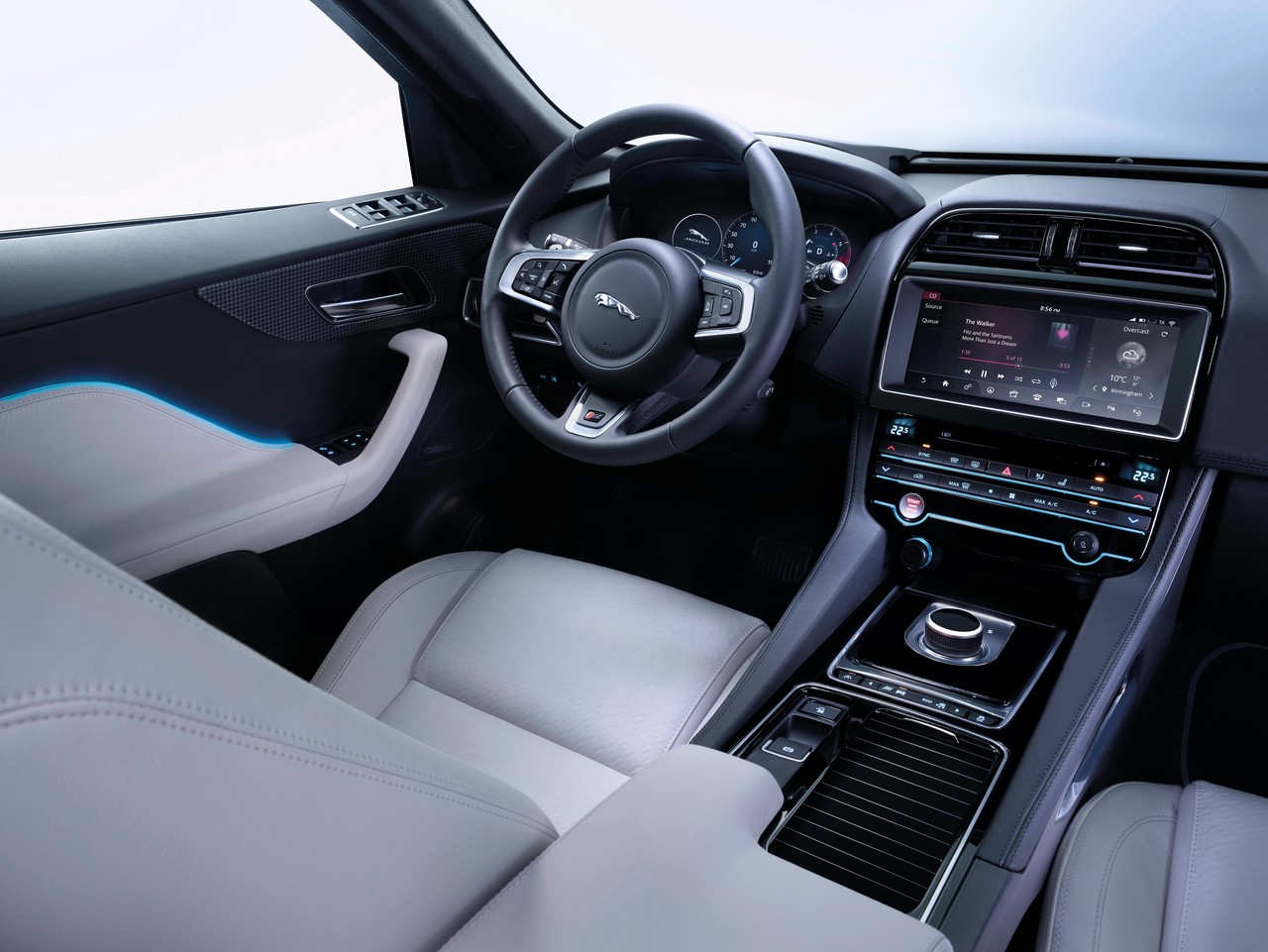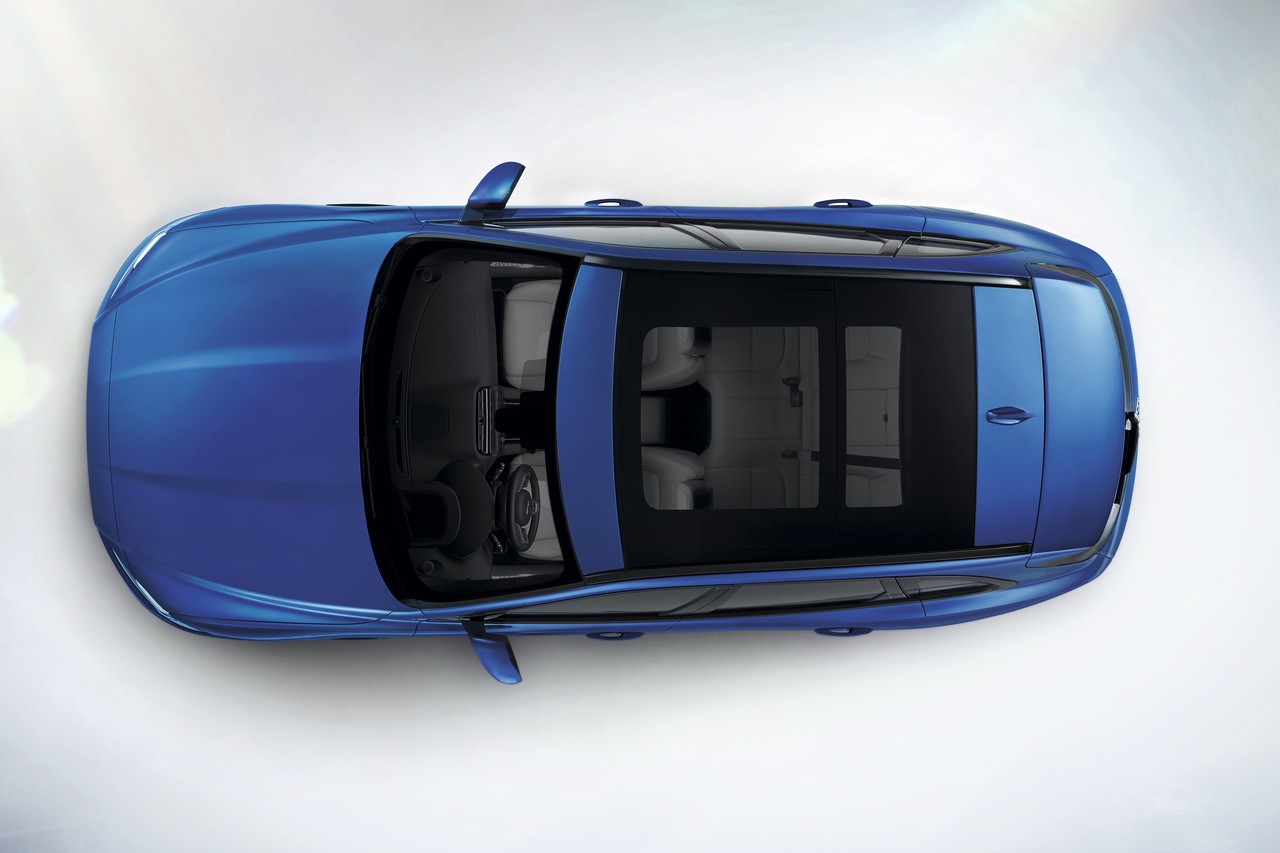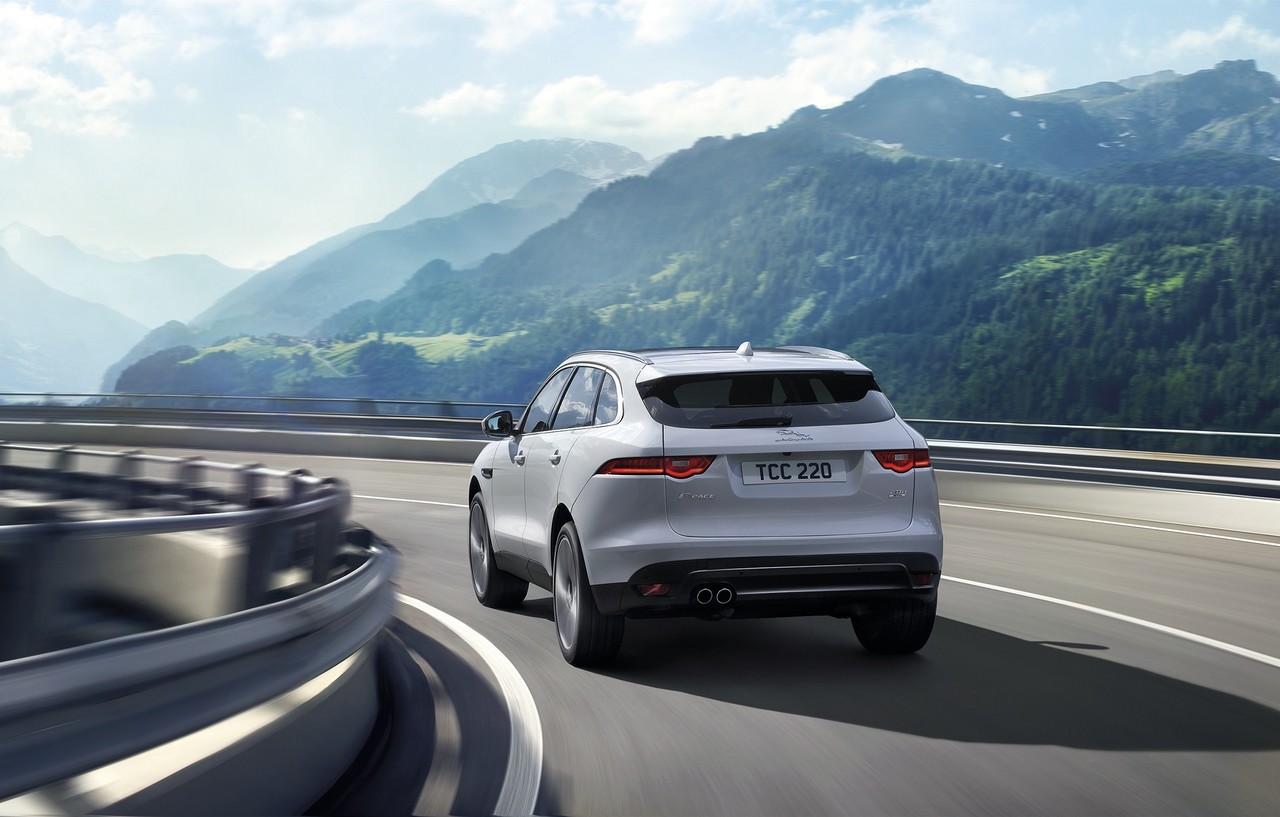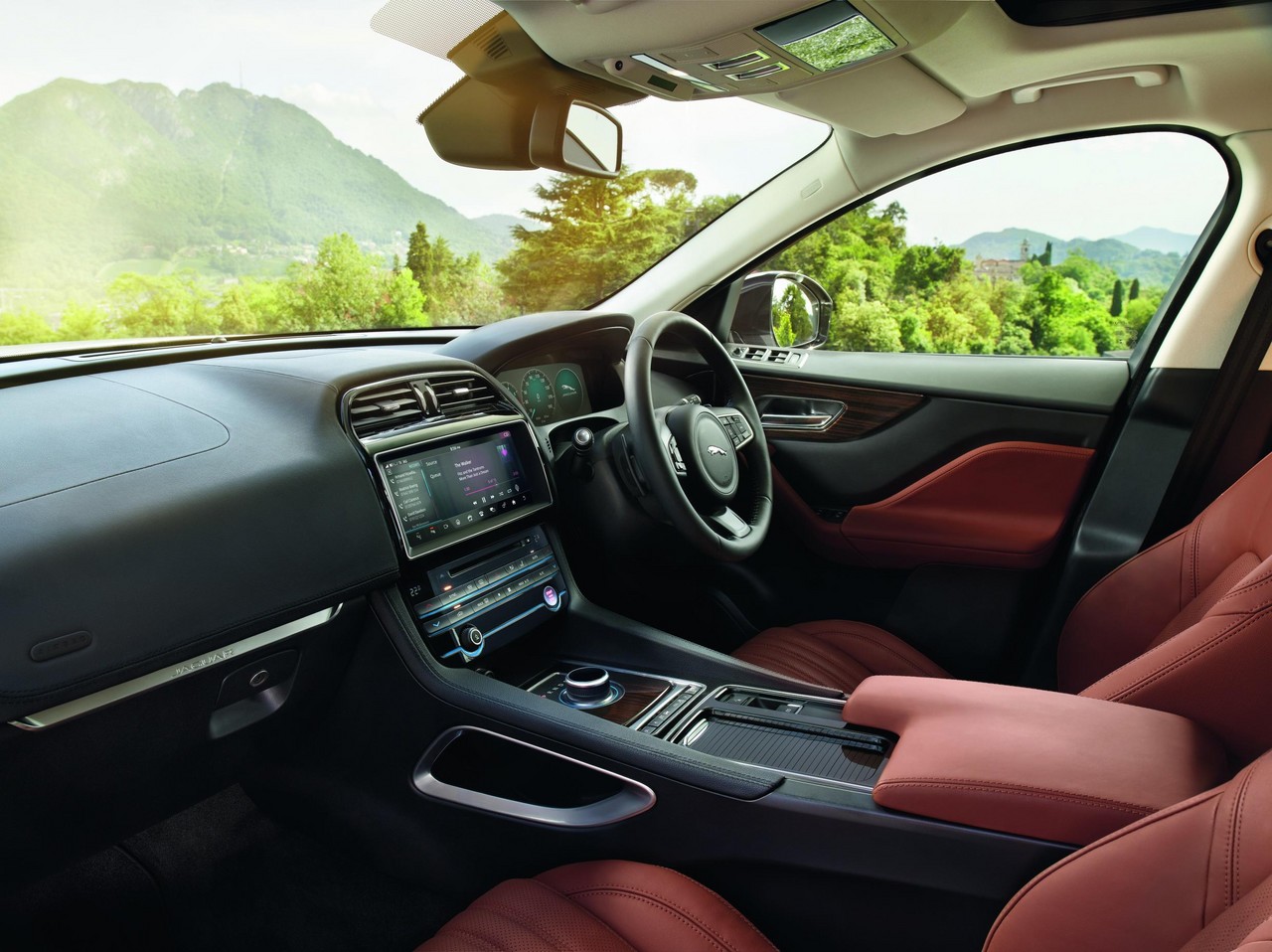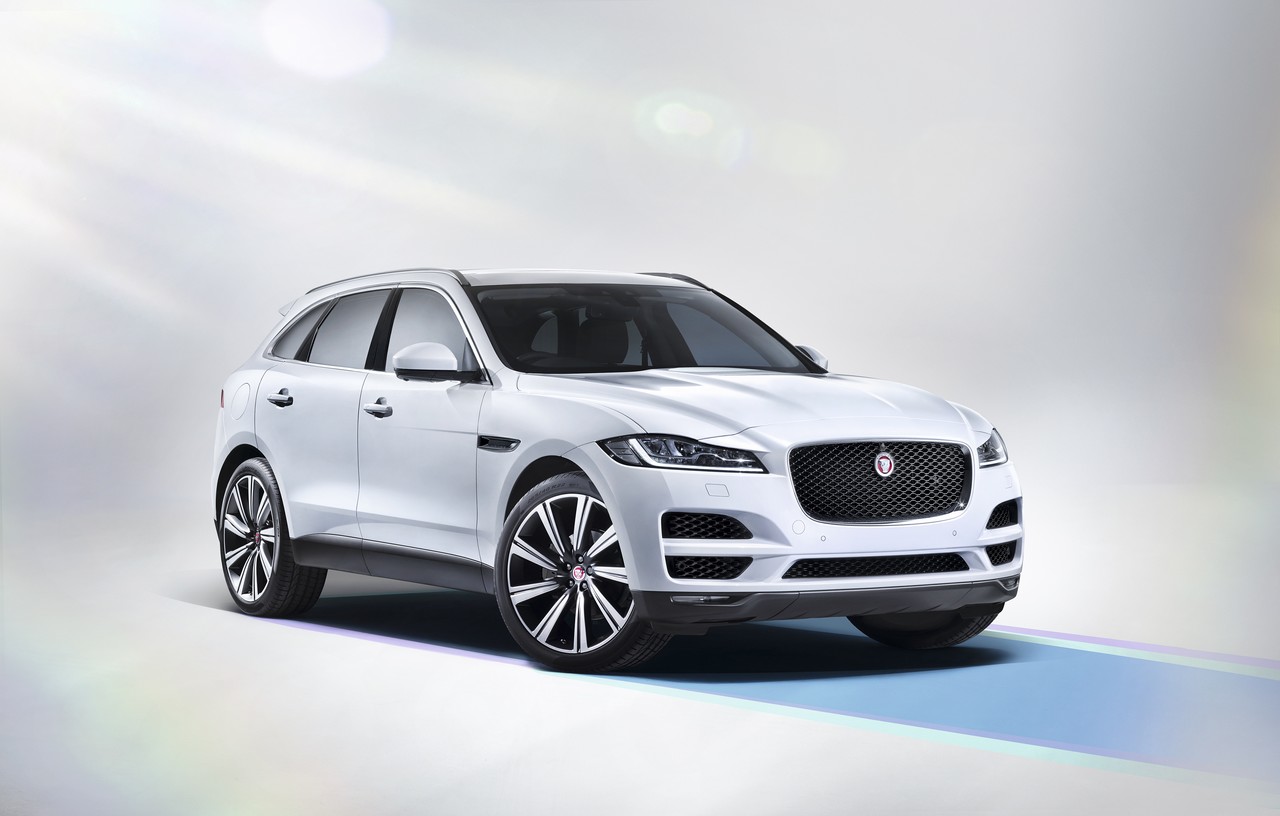
- Responsive V6 engines
- Spacious interior and boot
- Refined ZF automatic transmissions
- All-wheel drive system provides traction
- Generally impressive ride/handling balance…
- … but ride quality deteriorates on larger wheels
- Steering is vague and lacks feel around centre
- Idle noise and vibration from 2.0-litre ‘Ingenium’ diesel engine when cold
- Interior fit and finishes fall short of German rivals
- InControl Touch touchscreen is slow to react
Overview
Released in Australia in the third quarter of 2016, the Jaguar X761 F-Pace was a large, five-seat SUV. Manufactured in Solihull, UK, the all-wheel drive Jaguar F-Pace was available with 2.0-litre turbo-diesel (20d), 3.0-litre turbo-diesel (30d) and 3.0-litre supercharged petrol engines (35t and S), all of which had all-wheel drive systems and eight-speed automatic transmissions. Beyond the powertrains, the Australian range consisted of Prestige, R-Sport, Portfolio and S editions.
The Jaguar F-Pace SVR was available to order form April 2018.
Engines
The 2.0-litre four-cylinder turbo-diesel engine was a member of Jaguar’s ‘Ingenium’ engine family and, as such, had a deep-skirt aluminium cylinder block with thin-wall, press-fit cast iron liners. For the diesel Ingenium engines, other features include offset cylinder bearings, common-rail injection operating at up to 1800 bar, a single variable geometry turbocharger, double overhead camshafts with roller bearings, four valves per cylinder, a cam phaser for variable exhaust valve timing, a compression ratio of 15.5:1, exhaust gas recirculation (EGR), selective catalytic reduction (SCR) systems, split-cooling systems and twin counter-rotating balancer shafts
The 3.0-litre turbo-diesel engine had a compacted graphite iron (CGI) cylinder block, an aluminium alloy cylinder head, common-rail injection operating at up to 2000 bar through eight-hole nozzles, two parallel-sequential sequential turbochargers, double overhead camshafts, four valves per cylinder and a compression ratio of 16.1:1. Of the turbochargers, the primary turbocharger had ceramic ball bearings which reduced friction and provided more rapid boosting. For emissions control, the 3.0-litre diesel engine had exhaust gas recirculation (EGR) and a selective catalytic reduction (SCR) system.
Shared with the Jaguar F-Type Roadster and F-Type Coupe , the 3.0-litre supercharged V6 petrol engine had a lightweight die-cast aluminium block, cross-bolted main bearing caps, an aluminium alloy cylinder head, double overhead camshafts with dual independent variable cam timing (DIVCT), four valves per cylinder, a Roots-type twin vortex supercharger (mounted in the engine’s ‘V’), two water-cooled intercoolers, direct fuel injection operating at up to 150 bar, a compression ratio of 10.5:1 and a single balancer shaft.
Furthermore, all engines hd an ‘Intelligent Stop/Start’ function which could shut down the engine when the Jaguar F-Pace was stationary to reduce fuel consumption.
ZF transmissions
Transmission options for the F-Pace consisted of:
- For the 2.0-litre turbo-diesel engines, eight-speed ZF 8HP45 automatic transmissions; and,
- For the 3.0-litre turbo-diesel V6 and supercharged petrol V6 engines, eight-speed ZF 8HP70 automatic transmissions.
Across the F-Pace range, steering wheel gearshift paddles were fitted as standard.
| Variant | Edition | Engine | Years | Trans. | Peak power | Peak torque |
|---|---|---|---|---|---|---|
| 20d | Prestige, R-Sport |
2.0-litre turbo- diesel I4 |
2015-on | 8sp auto | 132 kW at 4000 rpm | 430 Nm at 1750-2500 rpm |
| 25d | Prestige, R-Sport |
2.0-litre twin turbo diesel I4 |
2017-on | 8sp auto | 177 kW at 4000 rpm | 500 Nm at 1500 rpm |
| 30d | Prestige, R-Sport, Portfolio |
3.0-litre twin-turbo diesel V6 | 2015-on | 8sp auto | 221 kW at 4000 rpm | 700 Nm at 2000 rpm |
| S, First Edition |
N/A | 3.0-litre twin-turbo diesel V6 | 2015-on | 8sp auto | 221 kW at 4000 rpm | 700 Nm at 2000 rpm |
| 35t | Prestige, R-Sport, Portfolio |
3.0-litre super charged petrol V6 | 2015-on | 8sp auto | 250 kW at 6500 rpm | 450 Nm at 3500-5500 rpm |
| S, First Edition |
N/A | 3.0-litre super charged petrol V6 | 2015-on | 8sp auto | 280 kW at 6500 rpm | 450N m at 4500 rpm |
| SVR | N/A | 5.0-litre super charged petrol V8 | 2018-on | 8sp auto | 405 kW at 6000-6500 rpm | 680 Nm at 3500-4000 rpm |
All-wheel drive (AWD) system
The Jaguar F-Pace had a torque on-demand all-wheel drive system which, in normal conditions, drove the rear wheels only. The system, however, continuously monitors grip levels and driver inputs so that additional torque could be directed to the front wheels in the event that wheel slip occurred or was anticipated. According to Jaguar, the ‘Intelligent Driveline Dynamics’ took ‘no more than 165 milliseconds’ to activate and could transfer up to 50 per cent of the engine’s torque to the front wheels via a transfer case which housed a multi-plate wet clutch and chain drive to the front axle.
All Surface Progress Control, Torque Vectoring and Low-Friction Launch
As standard, the Jaguar F-Pace was fitted with Jaguar’s ‘All-Surface Progress Control’ (ASPC) which controlled acceleration at speeds up to 30 km/h. Operating at speeds between 3.6 km/h and 30 km/h, the driver could activate ASPC and use the cruise control switches on the steering wheel to set the maximum speed. ASPC then accelerated the vehicle up to that speed, controlling the throttle and brakes (in opposition) to optimise traction on low-friction surfaces such as snow and ice.
As standard, the F-Type had a Torque Vectoring system which could apply ‘finely-metered’ braking to the inner wheels when cornering to mitigate understeer during corner entry. As an option, the F-Pace was also available with a Low-Friction Launch (LFL) function which used a progressive throttle map for finer acceleration control.
Aluminium monocoque and dimensions
Shared with the Jaguar X760 XE and X260 XF , the Jaguar F-Pace had a ‘Lightweight Aluminium Architecture’. For the F-Pace, the body structure:
- Comprised 80 per cent aluminium;
- Used advanced high strength steels in areas such as the rear floor; and,
- Was joined using 2616 self-piercing rivets, 72.9 metres of structural adhesive and 566 spot-welds.
According to Jaguar, the torsional stiffness of the F-Pace matched the Jaguar X260 XF . To minimise mass, the F-Pace had a composite tailgate and used magnesium for components such as the cross-car beam.
The Jaguar F-Pace was 4731 mm long, 1936 mm wide (excluding mirrors), 1652 mm tall (excluding antennae) and had a 2874 mm long wheelbase; cargo space was 650 litres. For off-road use, the F-Pace had ground clearance of 213 mm, a maximum wading depth of 525 mm, and maximum approach and departure angles of 25.5 and 26.0 degrees, respectively. Furthermore, the F-Pace had a drag coefficient of 0.34 Cd.
Suspension and steering
The Jaguar X761 F-Pace had double wishbone front suspension and an ‘Integral Link’ rear axle (which included upper links made from aluminium forgings and a hollow-cast aluminium lower arm). The standard suspension used monotube dampers, though the F-Pace S and First Edition were fitted with electronically-controlled dampers (Jaguar’s ‘Adaptive Dynamics’) which adjusted to driving conditions. According to Jaguar, the Adaptive Dynamics system measured body and wheel movement 100 and 500 times a second respectively.
The Jaguar F-Pace had rack-and-pinion steering with electric power-assistance and a variable ratio that depened on driving speed.
Safety equipment
Standard safety equipment for the Jaguar F-Pace included dual front airbags, front side airbags, full-length curtain airbags, ABS, electronic brake force distribution, brake assist, electronic stability control, traction control and front seatbelts with pre-tensioners and load limiters.
Fitted as standard, the F-Pace had a stereo camera – mounted behind the front windscreen – which provided a 3D view of the road up to 100 metres ahead. At speeds up to 80 km/h, the Autonomous Emergency Braking (AEB) system could use this information to detect if a collision was imminent and, if so,
- Pre-charge the braking system;
- Warn the driver via a visual warning in the instrument cluster (and head-up display where fitted); and,
- If the driver failed to respond, initiate emergency braking to avoid or mitigate a collision.
As standard, the Jaguar F-Pace was also fitted with a Lane Departure Warning System.
Optional, extra-cost safety equipment for the Jaguar F-Pace included:
- A Blind Spot Monitor;
- Reverse Traffic Detection;
- Lane Keep Assist; and,
- Driver Condition Monitor (for driver fatigue monitoring).
From April 2017 production, the F-Pace was available with the following technologies –
- Forward Traffic Detection: using a forward-facing camera that was mounted in the grille, Forward Traffic Detection sought to assist the driver when forward visibility was restricted by detecting items that may cross the vehicle’s path. If a hazard was detected, a visual warning would be provided on the central screen; and,
- Forward Vehicle Guidance: working in conjunction with the front parking sensors, Forward Vehicle Guidance provided a visual representation of the vehicle that was overlaid with wheel projections showing the alignment of the steering. Furthermore, drivers could see the parking distance displayed on the central screen.
Brakes
The Jaguar F-Pace 20d had 325 mm by 30 mm ventilated front brake discs and 325 mm by 20 mm solid rear discs. All other F-Pace variants, however, had 350 mm by 32 mm front brake discs.
Euro NCAP testing
In Euro NCAP testing , the 2017 Jaguar F-Pace received a five star safety rating which included a 93 per cent adult occupant protection rating, an 85 per cent child occupant protection rating and a 72 per cent ‘safety assist’ rating. In the frontal offset test, protection of the driver’s head, thighs, lower right leg and feet were rated as good, though protection of the driver’s chest and lower left leg were rated as adequate. Maximum points, however, were awarded in the side impact and pole tests.
Features: Jaguar F-Pace Prestige
Standard features for the Jaguar F-Pace Prestige included 19-inch ‘Fan’ five-spoke silver alloy wheels, a 380 watt Meridian sound system with eleven speakers, Bluetooth mobile phone connectivity and audio streaming, Jaguar’s ‘InControl Touch’ infotainment system with satellite navigation system and an eight-inch touch screen, dual-zone climate control air conditioning, ‘Taurus’ leather seats, ten-way power adjustable front seats with memory settings, bi-xenon headlights with washers, LED ‘J blade’ daytime running lights, front fog lights, front and rear parking sensors, a rear view camera, dusk-sensing headlights, rain-sensing wipers, 40:20:40 split folding rear seats, remote central locking, power adjustable and heated door mirrors with folding function, power windows, a height and reach adjustable steering wheel, an auto-dimming rear view mirror, push-button start, five power sockets, a power-operated tailgate, tyre pressure monitoring system, a trip computer, an alarm and immobiliser.
As standard, the Jaguar F-Pace was fitted with a space saver spare wheel.
Features: Jaguar F-Pace R-Sport
Relative to the Prestige, the F-Pace R-Sport was further equipped with 19-inch ‘Bionic 5’ twin-spoke grey and diamond turned finish alloy wheels, a soft-grain leather steering wheel, Cuir Grain wrapped instrument panel topper with contrast stitching and metal tread plates with ‘R-Sport’ branding.
Unique within the range, the F-Pace R-Sport featured Jaguar’s ‘Configurable Dynamics’ which provides variable settings for accelerator pedal response, steering weight and transmission behaviour.
Visually, the Jaguar F-Pace R-Sport could be identified by its unique bumpers (front and rear), grained black radiator grille with satin chrome surround, body-coloured R-Sport door claddings with Satin Black finishers, side ‘power’ vents with ‘R-Sport’ badges and gloss black side window surrounds.
Features: Jaguar F-Pace Porfolio
Compared to the F-Pace Prestige, the F-Pace Portfolio added 19-inch ‘Razor 7’ twin-spoke alloy wheels, ‘luxury’ seats with perforated ‘Windsor’ leather upholstery, Windsor leather door trim, LED headlights with washers, front headrests with an embossed Jaguar ‘leaper’, proximity key (i.e. keyless entry), gloss figured ebony veneers and interior mood lighting. Furthermore, the F-Pace Portfolio could be identified by its gloss black radiator grille with chrome surrounds.
Features: Jaguar F-Pace S
Relative to the F-Pace Prestige, the F-Pace S featured 20-inch ‘Blade’ five-spoke grey and diamond turned finish alloy wheels, combination Taurus leather and suede cloth sport seats, LED headlights with washers, a meshed aluminium trim finisher, front headrests with ‘S’ branded embossing, metal tread plates with ‘S’ branded embossing, bright sport pedals, suede cloth headlining and satin chrome gearshift paddles.
The F-Pace S could be identified by its unique bumpers (front and rear), gloss black radiator grille with satin chrome surrounds, gloss black side window surrounds and body-coloured ‘S’ door claddings with satin chrome finishers.
Features: Jaguar F-Pace First Edition
Compared to the F-Pace S, the F-Pace First Edition was distinguished by its 22-inch ‘Double Helix’ fifteen-spoke grey finish alloy wheels with contrasting inserts, Jaguar’s ‘InControl Touch Pro’ infotainment system which included a 10.2-inch touchscreen, quad-core processor, 60 GB solid-state drive and Ethernet networking, Windsor leather seats with ‘Houndstooth’ embossing and tonal double stitching, power reclining rear seats, a panoramic roof with electric opening, Windsor leather door trim, illuminated metal tread plates, ‘First Edition’ carpet mats, configurable mood lighting and loadspace storage rails. The F-Pace First Edition also features a 12.3-inch HD ‘virtual instrument cluster’ which can display full-screen navigation with 3D maps.
April 2017 update (‘2018 model year’)
From April 2017 production,
- A ‘Dual View’ screen was introduced for the InControl Touch Pro multimedia system. The Dual View screen enabled the driver and front passenger to view different infotainment displays from the central ten-inch touchscreen; and,
- The front seats for the F-Pace Portfolio featured powered headrest height adjustment and manually adjustable winged headrests.
Jaguar F-Pace SVR
The Jaguar F-Pace SVR was available to order from April 2018 and had a recommended retail price of $140,020 (plus on-road costs). Powered by a 5.0-litre supercharged V8 petrol engine, the F-Pace SVR could accelerate from rest to 100 km/h in 4.3 seconds and had a top speed of 283 km/h.
Visually, the Jaguar F-Pace SVR could be identified by its SVR aerodynamic package which included unique bumpers, lower body sides and rear ‘flip’ spoiler. The F-Pace SVR also had larger air intakes and bonnet vents to improve cooling, side fender vents to lower pressure in the wheel arches, wheel arch extensions and a rear bumper (with side strakes) that housed quad tailpipes. The F-Pace SVR also had a Variable Valve Active Exhaust system which reduced back pressure and was 6.6 kg lighter than the standard exhaust.
As standard, the Jaguar F-Pace SVR was fitted with 21-inch forged wheels and larger two-piece brake discs (395 mm front and 396 mm rear). For the suspension, front and rear spring rates were increased by 30 per cent and 10 per cent, respectively, while Jaguar claimed that stiffer anti-roll bars reduced body roll by 5 per cent. The F-Pace SVR was also fitted with Jaguar’s rear ‘Electronic Active Differential’ (EAD).
Inside, the Jaguar F-Pace SVR featured slimline sports seats with signature ‘lozenge’ quilting and embossed SVR logos, an SVR steering wheel with aluminium paddle shifts, and a ‘Sports Shift Selector’ (replacing the rotary selector).
Jaguar F-Pace 19MY
AustralianCar.Reviews expects the 2019 ‘model year’ (19MY) Jaguar F-Pace to be released in Australia in the third quarter of 2018. Although not confirmed for Australia, the 19MY Jaguar F-Pace introduces the following active safety technologies –
- High-Speed Emergency Braking which operates at speeds from 10-160 km/h;
- Adaptive Cruise Control with Steering Assist: operates at speeds from 0-180 km/h and uses the existing Adaptive Cruise Control functionality with Lane Centring to steer the vehicle within its lane as it maintains a set distance from the vehicle in front; and,
- Adaptive Cruise Control with stop & go: allows the driver to follow a vehicle to rest and resume from stationary when the driver prompts the system by tapping the accelerator pedal.
19MY F-Pace models with petrol engines will also have a larger, 82-litre fuel tank (previously 63 litres).
Inside, the 19MY F-Pace will be fitted with Jaguar’s ‘Touch Pro’ infotainment system – which has a ten-inch touchscreen – as standard. Beyond this, options will be extended to include ‘slimline’ sports seats with fourteen-way adjustment and adjustable bolsters, a suedecloth headlining and illuminated treadplates.
Specifications
- Specifications: Jaguar X761 F-Pace (February 2016)
- Specifications: Jaguar X761 F-Pace (September 2017)
Related links
- Jaguar Cars Australia: Jaguar F-Pace
- Jaguar Newsroom: The All-New Jaguar F-Pace (Press Kit)
- Wikipedia.org: Jaguar F-Pace
